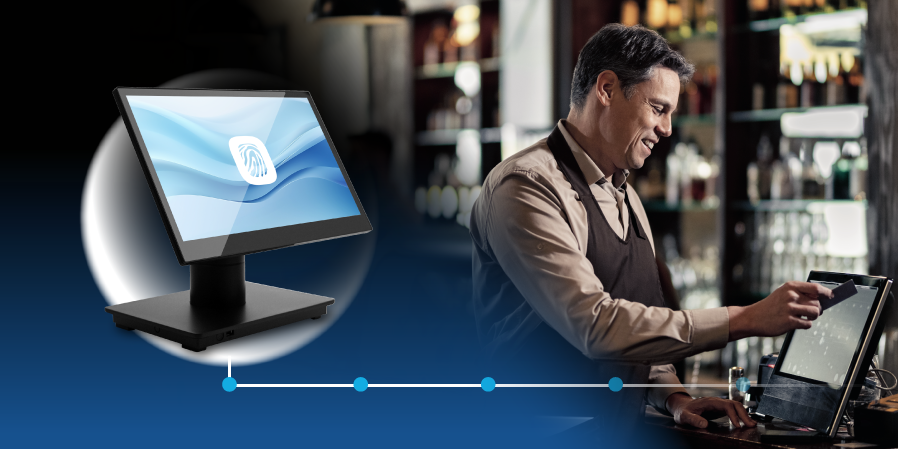
The Evolution of All-in-One POS Solutions
All-in-One POS: A New Era of Innovation
From the early electronic cash registers of the 1970s to today’s cloud-based, mobile tablets, point of sale (POS) systems have gone through a dynamic evolution over the past half century. Guided by faster connections and AI-based learning models, it’s easier than ever to combine sales, inventory, and other tools into a single, seamless system. Piecing together a POS system from various vendors and hoping it all works together is a gamble retailers can’t afford to make.
These days, successful retailers and restaurants depend on reliable all-in-one systems. They’re affordable, dependable, and offer users an easier, less stressful POS solution. And depending on how these POS systems are configured, their versatility allows for use as a traditional POS, a countertop kiosk, or a mobile tablet that can easily be carried throughout the establishment. The industry has taken an interesting and eventful journey to reach the point where it could give retailers leading-edge point of sale options.
From Cash Registers to Connected POS
Early Mechanical Cash Registers
Some of the first forms of point of sale devices were mechanical cash registers, and in terms of storing cash and giving customers change, they did their job relatively well. But their usage didn’t go much further than basic transaction recording. These early machines had limited functionality, no aggregate accounting features, and weren’t designed to integrate with any other business operations.
The Rise of Electronic Cash Registers (ECRs) and Electronic POS (EPOS)
In the early 1970s, retailers saw the rise of electronic cash registers (ECRs) and, later, electronic POS (EPOS). These systems were a significant step forward, offering better cash management and features like error-free receipts and more accurate reporting. Electronic systems ushered in the age of modular hardware like registers, printers, card readers, and more. Developers also expanded EPOS capabilities with valuable features like inventory management.
The Shift to Networked & Cloud POS
By the early 2000s, POS systems were connecting to the internet and offering users a whole new way of operating their point of sale. These innovative new systems had increased functionalities, greater accessibility, and real-time data synchronization.
These stunning advancements also meant retailers were now able to have visibility into sales and inventory across multiple locations, as well as integrate with internet-based tools. Over the next several years, smartphones and tablets ushered in the age of mobile POS systems (mPOS) and allowed retailers to take payments from anywhere at any time. With this expanded flexibility, POS terminals in the United States generated $6.89 billion in sales in 2023, and according to Grand View Horizon, that number is expected to reach $9.86 billion by 2030, making mobile terminals the fastest-growing devices in this segment.
What Makes a POS System Truly “All-in-One”?
Integration of Hardware & Software
An all-in-one POS system means that users rely on a single, comprehensive system for payments, reporting, customer engagement, and so much more. This incredible concept that easily integrates software and hardware has not only changed the game for retailers across the globe, but has also created a reduced footprint at the counter and is much easier to set up than previous systems.
Customer & Employee Experience
From a customer perspective, an all-in-one POS system allows for faster checkouts, seamless transactions, and the ability to make purchases with a multitude of payment methods, such as digital wallets and rewards programs. For sales associates and employees, these systems reduce training time and create a simpler way to manage loyalty programs, customer engagements, and more.
Operational Efficiency
With fewer devices and cables to manage, all-in-one POS systems offer a level of operational efficiency that retailers have grown to rely on. Today’s systems feature smoother internet connections and advanced scalability, creating a streamlined, modern approach to accepting payments and managing multiple aspects of a business. And with dedicated, around-the-clock IT support, retailers experience less downtime and fewer technical issues.
Today’s Demands Driving Innovation
In today’s retail environment, scalability is key. From the ability to handle seasonal peaks to expanding locations and staff, it’s important for retailers to scale their business while ensuring security and compliance aren’t compromised. The need for real-time data and customer personalization has also become a necessity, and retailers are delivering it with all-in-one POS systems.
The Next Generation: Designing Smarter All-in-One POS Solutions
The future of all-in-one POS systems includes AI-driven personalization and smart analytics that create more intuitive solutions. As these systems continue to evolve, we’re likely to see advancements in cloud-first support systems and mobile-first deployments. In addition, hardware longevity and future-proofing strategies for value-added resellers (VARs) will allow retailers to prioritize sustainability, diversify revenue streams, and ultimately stay ahead of the technology curve.
Hardware Design Meets Performance
As systems continue to become more efficient, the industry is getting used to having modern luxuries such as slimmer form factors, larger displays, and more ergonomic features. Integration with high-performance CPUs from manufacturers like Intel® and Qualcomm will also improve as hardware continues to be designed with one thing in mind—performance.
Adaptability Through Peripherals
One of the most crucial benefits of a POS system is its ability to adapt. From barcode scanners and fingerprint readers to customer-facing displays and other modern features, today’s systems balance modular flexibility with all-in-one simplicity, creating a more efficient way of doing business.
User-Centric Experiences
Many key features of modern POS systems revolve around increasing efficiency for retailers. But what about the user experience for customers? Innovative new functions make checking out easier and more convenient, like swivel displays that enhance customer engagement and touch interfaces designed for speed and usability.
Why All-in-One POS is the Future of Retail & Hospitality
We’ve come a long way from the days of mechanical cash registers. The point of sale evolution has led to incredible solutions that meet the challenges of today’s retail and restaurant industries. But having an all-in-one POS system that’s powerful and efficient can help maximize the opportunities of tomorrow and help businesses across the country continue to grow and thrive.
As you plan your next POS upgrade, be sure to explore how our solutions, like the Razor All-in-One, can streamline your operations and provide a flawless checkout experience. Learn more about the Touch Dynamic Difference today.
Media Contact
Marina Jones
Digital Marketing Assistant
(732) 382-5701 x124
mjones@touchdynamic.com
